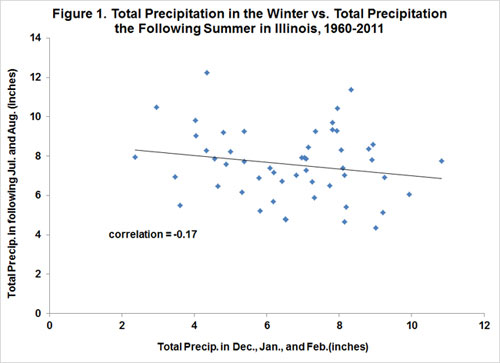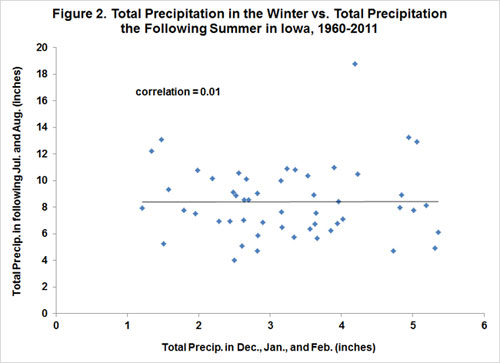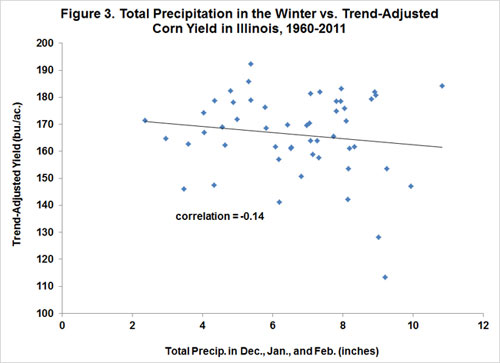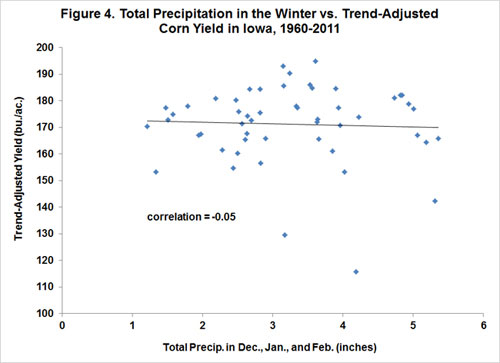



Winter Precipitation and Corn Yield
US - Due to the very warm temperatures in the winter of 2011-12, we recently examined the relationship between average winter temperatures and average temperatures the following summer and the relationship between average winter temperatures and corn yield, write Scott Irwin and Darrel Good.We showed that the correlation between average winter temperature and both average summer temperature and average state yield is small for Illinois and Iowa. Here we extend the analysis to the relationship between total state average precipitation during December, January, and February and the total precipitation in the following July and August. In addition, we examine the relationship between the total winter precipitation and the trend-adjusted corn yield the following year.Once again, the analysis is conducted for Illinois and Iowa (the two largest corn producing states) over the period 1960 through 2011.
The relationship between total winter and summer precipitation is presented in Figures 1 and 2. The correlations indicate a slight negative relationship between winter and summer precipitation in Illinois and virtually no relationship in Iowa (correlations can vary between -1 and +1, with zero indicating no relationship). The weakness of the relationships is most evident in the wide scatter of data points around each line. Winters with above- and below-average precipitation are associated with a wide range of precipitation the following summer.


Given the slight relationship between winter and summer precipitation in Illinois and Iowa, it would not be surprising to find little relationship between winter precipitation and the state average trend-adjusted corn yield the following year. That expectation is confirmed by Figures 3 and 4, which actually show a small negative relationship between average winter precipitation and trend-adjusted average state yield. Nonetheless, in contrast to winter temperatures, there is a logical reason to think that winter precipitation should actually be positively related to corn yields. Specifically, winter precipitation contributes to the preseason charging of soil moisture reserves, which ultimately contributes to higher yields. If one excludes several outliers from the plots (1983, 1988, and 1993) there is indeed a small positive relationship between winter precipitation and corn yield in both states. This is what we found in our previous modeling work on corn yields with the use of a more complete model specification. It is, of course, important to keep in mind that the impact of precipitation before the growing season is small compared to precipitation during the growing season. The yield impact of moving from the minimum to the maximum winter precipitation observed over 1960-2012 in both states is at most 5 bushels per acre.


Conclusion
There is little correlation between winter weather (temperature or precipitation) and summer weather. This is consistent with the view that, beyond seasonal tendencies, weather is very difficult to predict over time horizons longer than a few weeks. There may be some predictability over longer horizons due to so-called ENSO events (e.g., El Nino and La Nina), but the reliability of such patterns for predicting U.S. Corn Belt growing season conditions is still open to considerable debate.
In contrast to winter temperature, winter precipitation is likely to have a small impact on corn yields in the following growing season. The available data indicate December, January, and February precipitation in Illinois (6.8 inches) was near average and in Iowa (4.3 inches) above average. Preliminary data indicates March was drier than average. On balance, this suggests little impact of winter 2012 precipitation relative to trend yield in either state.







